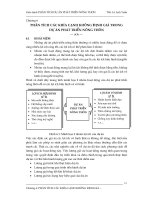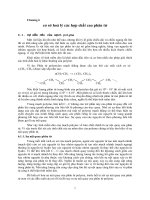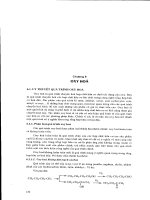Giao trinh bai tap dsp danh sach nhom bai tap chuong 6 03082015
Bạn đang xem bản rút gọn của tài liệu. Xem và tải ngay bản đầy đủ của tài liệu tại đây (751.65 KB, 34 trang )
Chapter 5
z-Transform
Nguyen Thanh Tuan, Click
M.Eng.
to edit Master subtitle style
Department of Telecommunications (113B3)
Ho Chi Minh City University of Technology
Email:
The z-transform is a tool for analysis, design and implementation of
discrete-time signals and LTI systems.
Convolution in time-domain multiplication in the z-domain
Digital Signal Processing
2
z-Transform
Content
1. z-transform
2. Properties of the z-transform
3. Causality and Stability
4. Inverse z-transform
Digital Signal Processing
3
z-Transform
1. The z-transform
The z-transform of a discrete-time signal x(n) is defined as the power
series:
X ( z)
x (n ) z n
x( 2) z 2 x ( 1) z x (0) x(1) z 1 x(2) z 2
n
The region of convergence (ROC) of X(z) is the set of all values of
z for which X(z) attains a finite value.
ROC {z C | X ( z )
x ( n) z
n
}
n
The z-transform of impulse response h(n) is called the transform
function of the filter:
H ( z)
n
h
(
n
)
z
n
Digital Signal Processing
4
z-Transform
Example 1
Determine the z-transform of the following finite-duration signals
a) x1(n)=[1, 2, 5, 7, 0, 1]
b) x2(n)=x1(n-2)
c) x3(n)=x1(n+2)
d) x4(n)=(n)
e) x5(n)=(n-k), k>0
f) x6(n)=(n+k), k>0
Digital Signal Processing
5
z-Transform
Example 2
Determine the z-transform of the signal
a) x(n)=(0.5)nu(n)
b) x(n)=-(0.5)nu(-n-1)
Digital Signal Processing
6
z-Transform
z-transform and ROC
It is possible for two different signal x(n) to have the same ztransform. Such signals can be distinguished in the z-domain by their
region of convergence.
z-transforms:
and their ROCs:
ROC of a causal signal is the
exterior of a circle.
Digital Signal Processing
7
ROC of an anticausal signal
is the interior of a circle.
z-Transform
Example 3
Determine the z-transform of the signal
x(n) a nu(n) b nu(n 1)
The ROC of two-sided signal is a ring (annular region).
Digital Signal Processing
8
z-Transform
2. Properties of the z-transform
Linearity:
if
and
z
x1 (n)
X 1 ( z ) with ROC1
z
x2 (n)
X 2 ( z ) with ROC2
then
z
x(n) x1 (n) x2 (n)
X ( z) X1 ( z) X 2 ( z) with ROC ROC1 ROC2
Example: Determine the z-transform and ROC of the signals
a) x(n)=[3(2)n-4(3)n]u(n)
b) x(n)=cos(w0 n)u(n)
c) x(n)=sin(w0 n)u(n)
Digital Signal Processing
9
z-Transform
2. Properties of the z-transform
Time shifting:
if
then
z
x(n)
X ( z)
z
x(n D)
z D X ( z)
The ROC of z D X (z ) is the same as that of X(z) except for z=0 if
D>0 and z= if D<0.
Example: Determine the z-transform of the signal x(n)=2nu(n-1).
Convolution of two sequence:
if
z
x1 (n)
X1 ( z)
z
x2 (n)
X 2 ( z)
and
z
then x(n) x1 (n) x2 (n)
X ( z) X1 ( z) X 2 ( z)
the ROC is, at least, the intersection of that for X1(z) and X2(z).
Example: Compute the convolution of x=[1 1 3 0 2 1] and h=[1, -2, 1] ?
Digital Signal Processing
10
z-Transform
2. Properties of the z-transform
Time reversal:
z
x(n)
X ( z ) ROC : r1 | z | r2
if
1
1
z
then
x ( n)
X ( z 1 ) ROC : | z |
r2
r1
Example: Determine the z-transform of the signal x(n)=u(-n).
Scaling in the z-domain:
z
x(n)
X ( z ) ROC : r1 | z | r2
if
then a n x(n)
z
X (a 1 z ) ROC : | a | r1 | z || a | r2
for any constant a, real or complex
Example: Determine the z-transform of the signal x(n)=ancos(w0n)u(n).
Digital Signal Processing
11
z-Transform
3. Causality and stability
A causal signal of the form
x(n) A1 p1nu(n) A2 p2nu(n)
will have z-transform
A1
A2
X ( z)
ROC| z | max | pi |
1
1
i
1 p1 z
1 p2 z
the ROC of causal signals are outside of the circle.
A anticausal signal of the form
x(n) A1 p1nu(n 1) A2 p2nu(n 1)
X ( z)
A1
A2
ROC| z | min | pi |
1
1
i
1 p1 z
1 p2 z
the ROC of causal signals are inside of the circle.
Digital Signal Processing
12
z-Transform
3. Causality and stability
Mixed signals have ROCs that are the annular region between two
circles.
It can be shown that a necessary and sufficient condition for the
stability of a signal x(n) is that its ROC contains the unit circle.
Digital Signal Processing
13
z-Transform
4. Inverse z-transform
transform
x(n) z
X ( z ), ROC
transform
X ( z), ROC inverse
z-
x(n)
z
x(n)
X ( z ), ROC
In inverting a z-transform, it is convenient to break it into its partial
fraction (PF) expression form, i.e., into a sum of individual pole
terms whose inverse z transforms are known.
1
Note that with X ( z )
-1 we have
1 - az
a nu (n) if ROC | z || a | (causal signals)
x ( n) n
a u (n 1) if ROC | z || a | (anticausal signals)
Digital Signal Processing
14
z-Transform
Partial fraction expression method
In general, the z-transform is of the form
N ( z ) b0 b1 z 1 bN z N
X ( z)
D( z )
1 a0 z 1 aM z M
The poles are defined as the solutions of D(z)=0. There will be M
poles, say at p1, p2,…,pM . Then, we can write
D( z ) (1 p1 z 1 )(1 p2 z 1 )(1 pM z 1 )
If N < M and all M poles are single poles.
where
Digital Signal Processing
15
z-Transform
Example 4d
Compute all possible inverse z-transform of
Solution:
- Find the poles:
1-0.25z-2 =0 p1=0.5, p2=-0.5
- We have N=1 and M=2, i.e., N < M. Thus, we can write
where
Digital Signal Processing
16
z-Transform
Example 5od
Digital Signal Processing
17
z-Transform
Partial fraction expression method
If N=M
Where
and
for i=1,…,M
If N> M
Digital Signal Processing
18
z-Transform
Example 6
Compute all possible inverse z-transform of
Solution:
- Find the poles:
1-0.25z-2 =0 p1=0.5, p2=-0.5
- We have N=2 and M=2, i.e., N = M. Thus, we can write
where
Digital Signal Processing
19
z-Transform
Example 6 (cont.)
Digital Signal Processing
20
z-Transform
Example 7 (cont.)
Determine the causal inverse z-transform of
Solution:
- We have N=5 and M=2, i.e., N > M. Thus, we have to divide the
denominator into the numerator, giving
Digital Signal Processing
21
z-Transform
Partial fraction expression method
Complex-valued poles: since D(z) have real-valued coefficients, the
complex-valued poles of X(z) must come in complex-conjugate pairs
Considering the causal case, we have
Writing A1 and p1 in their polar form, say,
with B1 and R1 > 0, and thus, we have
As a result, the signal in time-domain is
Digital Signal Processing
22
z-Transform
Example 8
Determine the causal inverse z-transform of
Solution:
Digital Signal Processing
23
z-Transform
Example 8 (cont.)
Digital Signal Processing
24
z-Transform
Some common z-transform pairs
Digital Signal Processing
25
z-Transform









